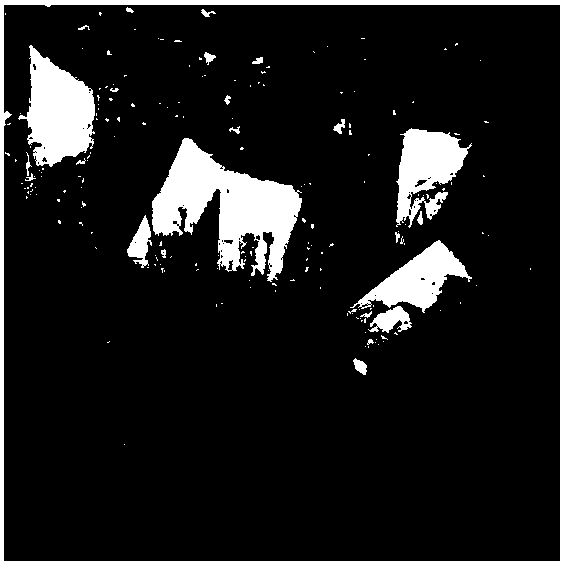Method for obtaining distant hybridization offspring of common head cabbage and cabbage type rape
A technology for Brassica napus and Cabbage, which is applied in the directions of horticultural methods, botanical equipment and methods, plant genetic improvement, etc., can solve the problems of abortion of young embryos, inability to obtain hybrid plants, etc., achieves restoration of fertility, shortens induction time, the effect of improving the embryo rate
- Summary
- Abstract
- Description
- Claims
- Application Information
AI Technical Summary
Problems solved by technology
Method used
Image
Examples
Embodiment 1
[0056] The female parent was selected from the cabbage Ogura cytoplasmic male sterile line cultivar Qingan 58 (2n=2x=18), and the male parent was selected from the excellent restorer line of rapeseed cultivar RFO-46 (2n=4x=38); selected disease-free Full parental seeds ready for planting, routine management;
[0057] Remove the flowers that have opened on the female parent's inflorescence 3 days before the hybridization at the initial flowering stage, tag the unopened flowers and bag them for isolation, take the anthers on the flowering day of the bagged male parent, and peel off the 4mm flower buds on the female parent plant for pollination ;
[0058] Cut the ovary 11 days after pollination, soak it with 70% ethanol for 30s, and then wash it with 0.1% HgCl 2 Disinfect for 15 minutes, then rinse with sterile water 4 times, 5 minutes each time;
[0059] The sterilized ovary was inoculated on the ovary induction medium under sterile conditions, and cultured for 20 days;
[00...
Embodiment 2
[0065] The female parent was selected from the cabbage Ogura cytoplasmic male sterile line cultivar Qingan 68 (2n=2x=18), and the male parent was selected from the excellent restorer line of rapeseed cultivar RFO-46 (2n=4x=38); selected disease-free Full parental seeds ready for planting, routine management;
[0066] Remove the bloomed flowers on the female parent's inflorescence 2 days before hybridization at the initial flowering stage, tag the unopened flowers and bag them for isolation, take the anthers on the flowering day of the bagged male parent, and peel off the 4mm flower buds on the female parent plant for pollination ;
[0067] Cut the ovary 13 days after pollination, soak it in 70% ethanol for 30s, and then wash it with 0.1% HgCl 2 Disinfect for 15 minutes, then rinse with sterile water 4 times, 5 minutes each time;
[0068] The sterilized ovary was inoculated on the ovary induction medium under sterile conditions, and cultured for 20 days;
[0069] The ovules ...
experiment example
[0074] The 10 hybrid plants that embodiment 1 and embodiment 2 obtain altogether carry out hybrid authenticity verification:
[0075] (1) Cytological identification: Sysmex CyFlow Cube8 flow cytometer was used to identify the ploidy of the hybrid offspring.
[0076] Prepare the solution: solution I is 4.2g citric acid, 0.5% Tween 20, dilute to 200mL, store at 4°C for later use; solution II is 28.65g sodium dihydrogen phosphate, PI20mg, dilute to 200mL.
[0077] Take 20mg of parent and hybrid F 1 The new leaves of the generation seedlings were placed in a plastic petri dish, and the leaves were chopped with a double-sided blade, and the cut samples were sucked up with a 1mL pipette gun and filtered into a 1.5mL Eppendorf tube through a 350-mesh nylon screen, and fresh I Suspend the sediment in 400 μL of the solution, add 800 μL of solution II to the sample when measuring the sample with a flow cytometer, and judge the hybrid F according to the abscissa position of the fluoresc...
PUM
 Login to View More
Login to View More Abstract
Description
Claims
Application Information
 Login to View More
Login to View More - R&D
- Intellectual Property
- Life Sciences
- Materials
- Tech Scout
- Unparalleled Data Quality
- Higher Quality Content
- 60% Fewer Hallucinations
Browse by: Latest US Patents, China's latest patents, Technical Efficacy Thesaurus, Application Domain, Technology Topic, Popular Technical Reports.
© 2025 PatSnap. All rights reserved.Legal|Privacy policy|Modern Slavery Act Transparency Statement|Sitemap|About US| Contact US: help@patsnap.com



